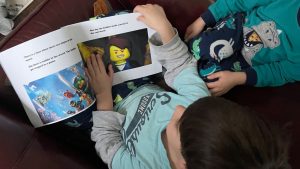Last week I found myself reflecting on events leading to an imaginative game that engaged my three boys for over an hour. In this article, I’m participating in another reflective exercise, but instead of presenting a timeline, I’m offering 5 tips to facilitate creative writing at home.
We sometimes talk about children’s interests or talents as this they emerged by chance. I take the position that they’re not always random acts but an outcome from a sequence of past events.
Research shows that the home environment significantly contributes to the differences we observe between our children. However, the home environment also contributes to their similarities.
See Also: 1 Tip to Support Imaginative Play in Children
Having three boys, I’ve had the opportunity to see my youngest look up to his big brothers. He wants to be like them. He is determined to replicate their actions. I believe this has contributed to advancements in his maturity, communications, and sensitivity compared to what we saw in them at a similar age (yes, I know, I’m flirting with comparisons, so let’s get back on track).

We printed one of my son’s ebooks at Staples. This is him reading his “published” book to his younger brother.
I share this story because my eldest started telling stories from a very young age. They began with simple drawings that I captured as videos; they then moved into making picture books and eventually writing words that turned into creative writing. Obviously, this progress correlated with advancement in literacy skills, but I believe some of our actions as parents helped lead to a family of three boys who has developed a passion for creative writing.

Don’t forget to Follow us on Facebook! We want more likes!
As a consequence of the eldest’s actions, the two younger siblings have replicated his creativity in this area and we now have three boys who regularly engage in creative writing activities to such an extent that we sometimes ask them to stop!
5 tips to facilitate creative writing at home
TIP 1: We’ve heard it before, but it starts with reading at an early age. Make books a part of their life as a baby. They will learn to appreciate words and become attentive to the way stories are told.
TIP 2: Don’t wait until they can write words. Their first pictures are stories, have them describe what’s happening in their pictures. As this activity progresses, encourage them to produce a sequence of pictures – almost like a storyboard. These make for great videos, as shown below.
TIP 3: Building upon tip 2, expose children to a variety of mediums. Use mobile devices to make videos, use apps to produce ebooks, share fictional and non-fictional stories at the dinner table.
TIP 3: When the writing begins, don’t get too bogged down with spelling and correcting the formation of letters. Focus on the content and the structure; the tools can come later.
TIP 4: Get excited about their work. When my boys finish, they’re proud of their work. Have them read it to you. Have them read it to each other. I’ll add that I got one of my middle son’s ebooks printed at Staples. This action took 30-minutes and motivated him to make even more books.
TIP 5: Get writing yourself (or share some of your past writing from school). In the opening paragraph, I referenced the importance of a home environment. I don’t think it’s a coincidence that my sons have heard me talking about finishing dissertation chapters and other chapters I’ve been working on in my research and then developed an interest in writing soon afterward.
